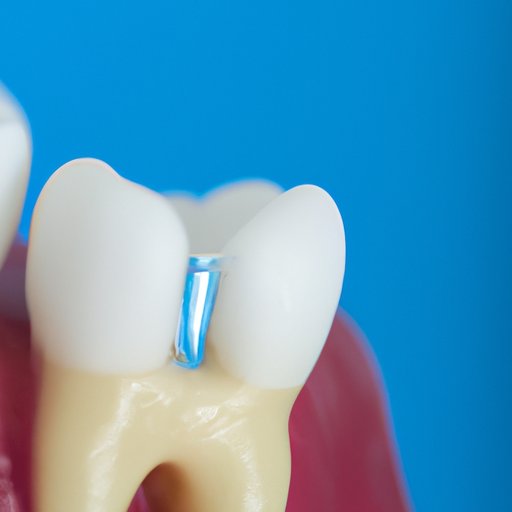
I. Introduction
A root canal is a dental treatment used to repair and save a tooth that is infected or decayed. During the procedure, the dentist removes the damaged portion of the tooth, cleans and disinfects the root canal, and then fills and seals the area.
Root canals are a common and effective treatment option, but they can be intimidating. This article aims to help readers recognize the symptoms of a potential root canal and provide information on the treatment process.
II. Symptoms to Watch For
The following symptoms may indicate a need for a root canal:
Severe Tooth Pain
If you experience consistent, severe pain in a tooth, it may be a sign that the tooth’s nerve and blood vessels are infected or damaged.
Sensitivity to Hot and Cold
If you feel a sharp pain or sensitivity to hot or cold foods and beverages, it may also be a sign of tooth damage, decay or infection.
Swelling
If you notice swelling around the affected tooth or in your face, it may be a sign of an infection that requires treatment.
Tenderness in the Gums or Jaw
If the area around the affected tooth is tender to the touch, it may be another indication of an infection or damage.
Symptoms may differ depending on the severity of the problem. Some patients may experience only one or two of the symptoms mentioned above; others may experience all four.
If you experience any of these symptoms, it is essential to seek dental treatment.
III. Comparisons to Other Treatments
A root canal is not the only option for patients with tooth damage, decay or infection. Other dental treatments include fillings, crowns, and extractions. However, a root canal may be the best option for patients with severe or persistent symptoms.
Root Canal vs. Filling
A filling is typically used for minor tooth decay or damage that doesn’t reach the root of the tooth. If the decay or damage has affected the nerve of the tooth, a root canal may be necessary.
Root Canal vs. Crown
A crown is a tooth-shaped cap that is placed over a damaged tooth to restore its shape, size, strength, and appearance. If the tooth is severely decayed or damaged, a root canal may be necessary before a crown can be fitted.
Root Canal vs. Extraction
Extraction is the removal of a tooth from the mouth due to damage or decay that cannot be repaired. A root canal may be preferable to an extraction because it can save the natural tooth and prevent the need for further dental treatment.
IV. Prevention Tips
While accidents and unexpected dental issues can occur, many patients can prevent the need for a root canal by taking good care of their teeth and gums. Recommendations include:
Good oral hygiene
Brushing twice a day and flossing daily can help keep your teeth healthy and avoid dental problems. Using mouthwash can also help kill bacteria and protect against tooth decay.
Regular checkups with the dentist
Regular dental checkups can catch problems before they become emergencies, saving you time, money, and pain in the long run.
Avoid certain behaviors that can damage teeth
Avoiding hard foods and candies, as well as behaviors such as using your teeth to open things, can prevent damage and decay.
V. Overview of the Procedure
A root canal procedure typically involves the following steps:
Initial Examination
During the first appointment, the dentist will take an X-ray of the affected tooth to determine the extent of the damage. The dentist will also numb the area, place a dental dam to protect the tooth, and make an access hole in the top of the tooth.
Cleaning the Canal
The dentist will use small files to remove the damaged or infected pulp from the tooth and root canal.
Filling and Sealing
The dentist will then fill the cavity with a rubber-like material called gutta-percha and seal the access hole with cement.
Post-Procedural Care
The tooth may feel sensitive for a few days after the procedure. Patients need to take care of the area and may need to return for a follow-up appointment to assess healing and make sure the tooth is protected with a crown or other dental restoration.
VI. Q&A with a Dentist
What is a root canal?
A root canal is a procedure for repairing and saving a tooth that is infected or decayed. The process involves removing the damaged or dead pulp, thoroughly cleaning out the inside of the tooth, and preventing future infection by sealing the tooth with a filling.
Is a root canal painful?
The root canal procedure itself is usually no more painful than a filling. Patients may feel tenderness or mild discomfort for a few days after the procedure. Over-the-counter pain medication can help alleviate symptoms.
How do I know if I need a root canal?
If you are experiencing severe tooth pain, sensitivity to hot and cold, swelling, or tenderness in the gums or jaw, you may need a root canal.
Is it better to have a root canal or an extraction?
In general, it is better to save the natural tooth if possible. A root canal can remove an infection and restore the tooth’s function, whereas an extraction removes the tooth entirely.
Conclusion
While a root canal can seem daunting, it is an effective way to save a damaged or infected tooth. By recognizing the symptoms and knowing the treatment options, patients can take care of their dental health and avoid more serious problems in the future.
If you experience any of the symptoms mentioned in this article, don’t hesitate to make an appointment with your dentist. With proper care and attention, you can maintain a healthy smile for years to come.




